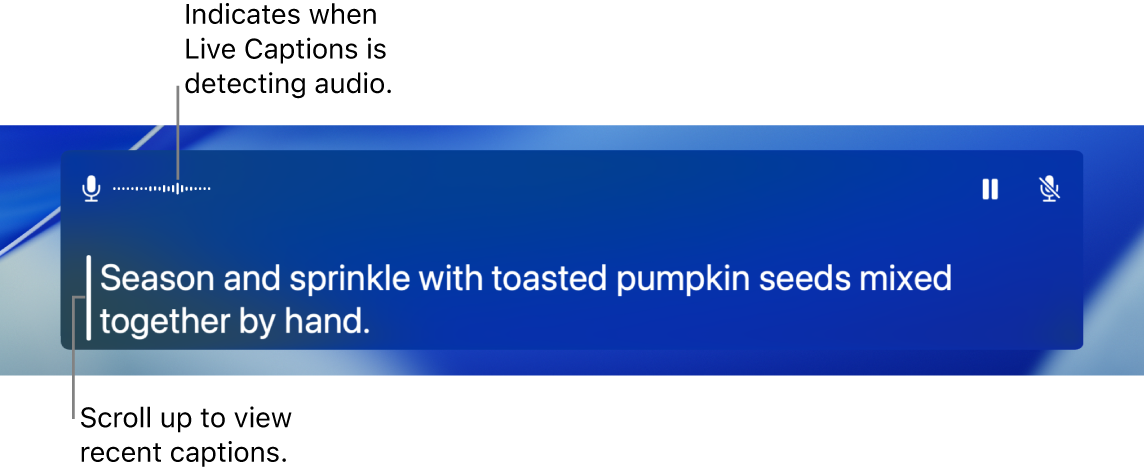
Get live captions of spoken audio on Mac
Live Captions gives you a real-time transcription of spoken audio — allowing you to easily follow the audio in any app, such as FaceTime or Podcasts, as well as live conversations around you. Audio is processed on device.

Note: Live Captions is available only on Mac computers with Apple silicon and is not available in all languages, countries or regions; see macOS Feature Availability for more information. The accuracy of Live Captions may vary and should not be relied upon in high-risk or emergency situations.
Turn Live Captions on or off
On your Mac, choose Apple menu

 in the sidebar, then click Live Captions. (You may need to scroll down.)
in the sidebar, then click Live Captions. (You may need to scroll down.)Turn Live Captions on or off.
The Live Captions window appears on the screen, but is automatically hidden if no audio is detected. If you want the Live Captions window to always be visible on the screen, click
 in the menu bar, then choose Keep On Screen.
in the menu bar, then choose Keep On Screen.Note: The first time you turn on Live Captions, language data is downloaded to your Mac. You must be connected to the internet.
By default, Live Captions transcribes audio from all apps. If you only want to use Live Captions in FaceTime, see Turn on Live Captions in FaceTime.
Use Live Captions
When you turn on Live Captions on your Mac, audio is transcribed in real time in the Live Captions window.
You can pause captioning at any time, without turning Live Captions off. Do one of the following:
Click
 in the Live Captions window. Click
in the Live Captions window. Click  to restart captioning.
to restart captioning.Click
 in the menu bar, then choose Stop Live Captions. Choose Start Live Captions to resume captioning.
in the menu bar, then choose Stop Live Captions. Choose Start Live Captions to resume captioning.
If you use VoiceOver and a braille display, when Live Captions is turned on, you can access the Live Captions window from the System Dialogues menu in the Application Chooser. See Use Live Captions with a braille display.
Have what you type spoken out loud
While in a conversation — in person or during a call — your Mac can speak what you type.
In the Live Captions window on your Mac, click the Type to Speak field, enter what you want to say, then press the Return key.
To indicate that your text is being read out loud, a message is shown in the top-left corner of the Live Captions window.
Note: If you don’t see the Type to Speak text field, click
 in the menu bar, then choose Type to Speak.
in the menu bar, then choose Type to Speak.
If you’re unable to speak or have lost your speech over time, you can also use Live Speech to have what you type spoken out loud in one of dozens of system voices or a Personal Voice you create.
Change what audio is captioned
When you use Live Captions, you can switch between captioning the audio coming out of your Mac and the sound picked up by the computer’s microphone (such as during an in-person conversation).
Do one of the following:
Click
 in the top-right corner of the Live Captions window to switch between your Mac computer’s audio output and its microphone audio input.
in the top-right corner of the Live Captions window to switch between your Mac computer’s audio output and its microphone audio input.Click
 in the menu bar, then choose Computer Audio or Microphone.
in the menu bar, then choose Computer Audio or Microphone.
Customise the appearance of captions
On your Mac, choose Apple menu

 in the sidebar, then click Live Captions. (You may need to scroll down.)
in the sidebar, then click Live Captions. (You may need to scroll down.)Change any of the following:
Font family: Change the font used in captions.
Font size: Increase or decrease the text size used in captions.
Font colour: Change the text colour used in captions
Background colour: Change the background colour of the Live Captions window.
You can resize the Live Captions window by dragging any edge and change its position on the screen. To restore the window to its default size and position, click ![]() in the menu bar then choose Restore Default Position.
in the menu bar then choose Restore Default Position.
You can also set an option to always show the Live Captions window, even when no audio is detected. Click ![]() in the menu bar, then choose Keep On Screen.
in the menu bar, then choose Keep On Screen.
You can use Accessibility Shortcuts to quickly turn Live Captions on or off.
You can also use keyboard shortcuts for many Live Captions actions, such as turning them on or off and changing the audio source. To view and customise available shortcuts, choose Apple menu 
![]() in the sidebar (you may need to scroll down), click Keyboard Shortcuts, then click Accessibility. See Use macOS keyboard shortcuts.
in the sidebar (you may need to scroll down), click Keyboard Shortcuts, then click Accessibility. See Use macOS keyboard shortcuts.